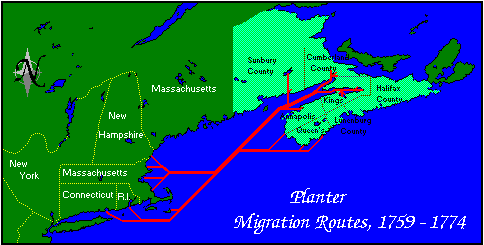On October 12, 1758 Governor Charles lawrence issued a proclomation to the people of New England inviting them to settle the fertile Nova Scotian farmland that had lain vacant since the expulsion of the Acadians. Agents representing potential settlers began pouring into Nova Scotia the following year, and in 1760 the immigration began in earnest. Within eight years, approximately 8,000 New Englanders had made the move, in the process, Nova Scotia was permanently transformed.

Although they were a diverse group, most of the New England Planters (an Elizabethan term for colonists) were either farmers or fishermen. The farmers, primarily from Connecticut, Rhode Island, and Massachusetts, settled on the former Acadian lands in the Annapolis Valley, Minas Basin, and Isthmus of Chignecto regions. the most populous agricultural townships were Cornwalis, Horton, and Annapolis.
Placing British subjects on the Acadian lands was Lawrence's first priority. However, New England Fishermen had been visiting Nova Scotia's shores for decades, and they too were interested in moving. Accordinly, the Nova Scotian government decided to admit them on the same basis as the farmers - a maximum of 1,000 acres of land with no rent for the first ten years. Most came from Massachusetts, and settled mainly in Liverpool, Yarmouth and Barrington townships.
In religion, most Planters were Protestant Dissenters, primarily Congregationalists, who stressed the role of the local congregation in church affairs. The Congregational Church was weakened during the American Revolution when most of its ministers returned to New England to support the revolutionary cause. Deprived of its clergy, the church lost many members to the evangelical Newlight movement, and outgrowth of New England's Great Awakening.
A depressed economy and geographic isolation were important factors behind Planter neutrality during the American Revolution, but so was the Great Awakening. Nova Scotians were preoccupied not with secular affairs but with spiritual ones. In that spiritual realm, some Planters accomplished their own revolution, rejecting established religion in favour of revivalism.
After the American Revolution, Planter influence was diminished as the Loyalists swarmed into Nova Scotia. Nevertheless, the Planters remained a vibrant force. The Newlights largely joined forces with the Baptist Church, while the more conservative Congregationalists adopted Presbyterianism. Others became Anglicans. The Congregational Church itself survived until 1925, when it became part of the United Church of Canada.
In politics, the democratic values of the Planters were evident in the 19th century struggle against the Halifax elite for religious and educational equality. Acadia University, begun in 1838, is a tangible reminder of that struggle. Planter influence was also felt in the Reform party, which fought successfully for responsible government. Two Canadian Prime Ministers - Sir Charles Tupper and Sir Robert Borden- were of Planter ancestry.
 Drop us a line!
Drop us a line!
| Dalry | Origins | Harveys | James | Archibald | Robert | |
| Little Arch | Joseph | Everett | Orace | Bruce | Christine |